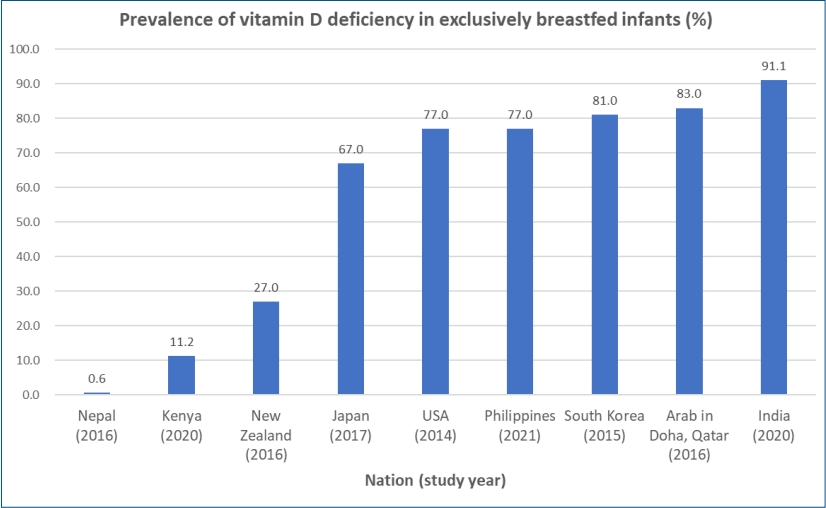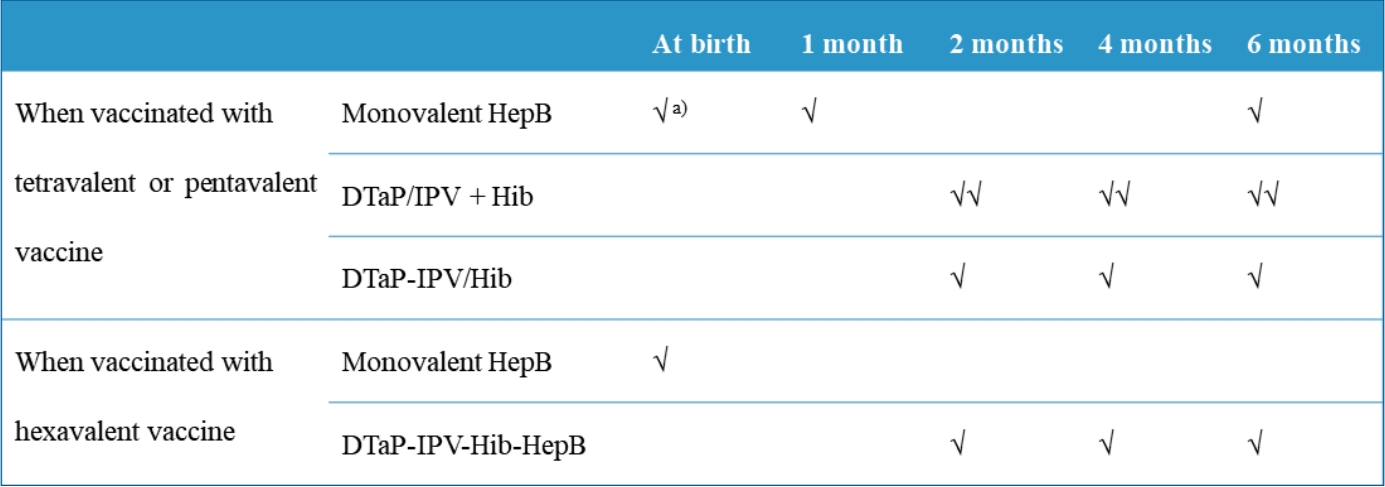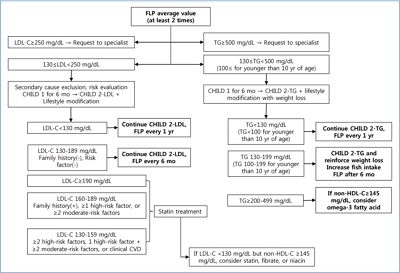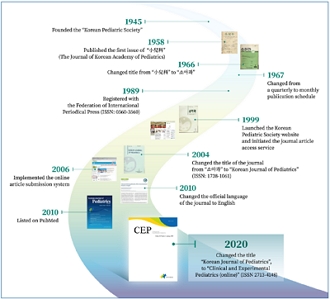Search
- Page Path
-
- HOME
- Search
- Review Article
- General Pediatrics
- Protecting our future: environmental hazards and children’s health in the face of environmental threats: a comprehensive overview
- Jungha Lee, Hyo-Bin Kim, Hun-Jong Jung, Myunghee Chung, So Eun Park, Kon-Hee Lee, Won Seop Kim, Jin-Hwa Moon, Jung Won Lee, Jae Won Shim, Sang Soo Lee, Yunkoo Kang, Young Yoo; The Environmental Health Committee of the Korean Pediatric Society
- Clin Exp Pediatr. 2024;67(11):589-598. Published online October 31, 2024
-

· Exposure to air pollutants cause allergic and respiratory diseases as well as chronic kidney disease.
· Adequate physical activity and proper nutrition are essential for children to maintain good health.
· We must educate people about the harmful effects of noise, blue light, heavy metals and smoke.
· Government and society must actively decrease environ-mental hazards.
- Original Article
- Neonatology (Perinatology)
- Mortality of very low birth weight infants by neonatal intensive care unit workload and regional group status
- Sung-Hoon Chung, Chae Young Kim, Yong-Sung Choi, Myung Hee Lee, Jae Woo Lim, Byong Sop Lee, Ki-Soo Kim; the Korean Neonatal Network
- Clin Exp Pediatr. 2024;67(11):619-627. Published online September 12, 2024
-

Question: How do structural and staffing characteristics of neonatal intensive care units (NICUs) influence the mortality rates of very low birth weight infants (VLBWIs)?
Findings: NICUs with higher staffing levels, particularly with more neonatologists, and those offering advanced care levels were associated with lower mortality rates. Additionally, regional disparities were observed, with some areas demon-strating significantly higher survival rates.
Meaning: Adequate staffing and equitable regional distribution of medical resources are crucial for improving survival outcomes in VLBWIs. Efforts to enhance NICU staffing and address regional healthcare disparities are essential for optimizing care quality and reducing mortality in this vulnerable population.
- Infection
- Clinical characteristics of pediatric patients infected with SARS-CoV-2 versus common human coronaviruses: a national multicenter study
- In Suk Sol, Eun Lee, Hyeon-Jong Yang, Yong Ju Lee, Hye Yung Yum, Mi-Hee Lee, Mi Ae Chu, Hui Jeong Moon, Hyo-Bin Kim, Ju Hee Seo, Jung Yeon Shim, Ji Young Ahn, Yoon Young Jang, Hai Lee Chung, Eun Hee Chung, Kyunghoon Kim, Bong-Seong Kim, Cheol Hong Kim, Yang Park, Meeyong Shin, Kyung Suk Lee, Man Yong Han, Soo-Jong Hong, Eun Kyeong Kang, Chang Keun Kim; on behalf of The Pneumonia & Respiratory Disease Study Group of Korean Academy of Pediatric Allergy and Respiratory Disease
- Clin Exp Pediatr. 2023;66(3):134-141. Published online December 22, 2022
-

Question: The clinical differences between severe acute respiratory syndrome coronavirus-2 (SARS-CoV-2) and human coronaviruses (HCoV) in children remain unknown.
Finding: This study compared the clinical findings of children infected with SARS-CoV-2 versus HCoV. Its findings suggest that children and adolescents with SARS-CoV-2 have a milder clinical course than those with HCoV.
Meaning: The clinical course of children and adolescents with SARS-CoV-2 should be closely monitored during the coronavirus disease 2019 pandemic.
- Perspective
- Infection
- Statement on healthcare system preparedness in response to COVID-19 Omicron subvariants BA.4 and BA.5 surge in Korea from the Korean Pediatric Society and Korean Society of Pediatric Infectious Diseases
- Eun Young Cho, Dong Hyun Kim, Soo-Han Choi, Ki Wook Yun, Jong Gyun Ahn, Hye-Kyung Cho, Hyunju Lee, Jina Lee, Taek-Jin Lee, Byung-Wook Eun, Jin Lee, Dae Sun Jo, Yun-Kyung Kim, Yae-Jean Kim; Committee on Infectious Diseases of the Korean Pediatric Society
- Clin Exp Pediatr. 2022;65(11):510-511. Published online September 23, 2022
-
In order to respond to the recent surge in coronavirus disease 2019 (COVID-19) cases and the continuously changing epidemiology of COVID-19, a sustainable and flexible pediatric healthcare system must be prepared considering the specificity of pediatric care. We demand a more proactive response from the health authorities to check the current state of pediatric COVID-19 patient care and to ensure that pediatric patients receive appropriate and timely management.
- Review Article
- Neonatology (Perinatology)
- Breastfeeding and vitamin D
- Ju Sun Heo, Young Min Ahn, Ai-Rhan Ellen Kim, Son Moon Shin; for the Korean Society of Breastfeeding Medicine
- Clin Exp Pediatr. 2022;65(9):418-429. Published online December 14, 2021
-

∙ Exclusively breastfed infants are at risk of developing vitamin D deficiency associated with hypocalcemia, rickets, and various health outcomes.
∙ The prevalence of vitamin D deficiency in breastfed infants differs vastly between studies and nations at 0.6%–91.1%.
∙ The vitamin D content of breast milk does not meet the requirements of exclusively breastfed infants.
∙ Most international guidelines recommend that breastfed infants be supplemented with 400 IU/day of vitamin D during the first year of life.
∙ Vitamin D intake (milk+supplements) of 800 IU/day can be considered in preterm infants along with biochemical monitoring.
- Infection
- Recommendation for use of diphtheria and tetanus toxoids and acellular pertussis, inactivated poliovirus, Haemophilus influenzae type b conjugate, and hepatitis B vaccine in infants
- Hye-Kyung Cho, Su Eun Park, Yae-Jean Kim, Dae Sun Jo, Yun-Kyung Kim, Byung-Wook Eun, Taek-Jin Lee, Jina Lee, Hyunju Lee, Ki Hwan Kim, Eun Young Cho, Jong Gyun Ahn, Eun Hwa Choi; The Committee on Infectious Diseases of the Korean Pediatric Society
- Clin Exp Pediatr. 2021;64(12):602-607. Published online June 8, 2021
-

∙ Diphtheria and tetanus toxoids and acellular pertussis-inactivated poliovirus-Haemophilus influenzae type b-hepatitis B (DTaP-IPV-Hib-HepB) was licensed in Korea in April 2020.
∙ DTaP-IPV-Hib-HepB is indicated as a 3-dose primary series for infants aged 2, 4, and 6 months who received the standalone HepB vaccine at birth.
∙ Infants born to HepB surface antigen-positive mothers are currently recommended to be immunized with HepB immunoglobulin at birth and then monovalent HepB vaccine at 0, 1, and 6 months.
- General Pediatrics
- Clinical features, diagnosis, and outcomes of multisystem inflammatory syndrome in children associated with coronavirus disease 2019
- Ji Hee Kwak, Soo-Young Lee, Jong-Woon Choi; the Korean Society of Kawasaki Disease
- Clin Exp Pediatr. 2021;64(2):68-75. Published online December 30, 2020
-

Hundreds of cases of children and adolescents with hyperinflammatory responses such as Kawasaki disease have been reported amid the coronavirus disease 2019 (COVID-19) pandemic, leading to coining of the new term COVID-19–associated multisystem inflammatory syndrome in children. In this review article, we introduce the illness and describe its case definitions, epidemiology, pathogenesis, clinical features, treatments, and outcomes.
- Guideline
- Endocrinology
- 2017 Clinical practice guidelines for dyslipidemia of Korean children and adolescents
- Jung Sub Lim, Eun Young Kim, Jae Hyun Kim, Jae-Ho Yoo, Kyung Hee Yi, Hyun Wook Chae, Jin-Ho Choi, Ji Young Kim, Il Tae Hwang; the Committee of Dyslipidemia of Korean Children and Adolescents on behalf of Korean Society of Pediatric Endocrinology (KSPE)
- Clin Exp Pediatr. 2020;63(12):454-462. Published online November 25, 2020
-

Question: How are children and adolescents with dyslipidemia treated and managed in Korea?
Finding: 2017 guidelines recommend to measure nonfasting non-HDL-C as a screening test and introduce new diet methods: Cardiovascular Health Integrated Lifestyle Diet (CHILD)-1, CHILD-2-low-density lipoprotein cholesterol, and CHILD-2-triglyceride. Statin is the only drug approved in children older than 10 years.
Meaning: New clinical practice guidelines for treating and managing dyslipidemia of Korean children and adolescents are provided.
- Review Article
- Neonatology (Perinatology)
- Neurodevelopmental outcomes of very low birth weight infants in the Neonatal Research Network of Japan: importance of neonatal intensive care unit graduate follow-up
- Yumi Kono; on behalf of the Neonatal Research Network of Japan
- Clin Exp Pediatr. 2021;64(7):313-321. Published online November 9, 2020
-

· Very low birth weight infants remain at high risk of developing neurodevelopmental impairments in early childhood.
· It is important to establish a network follow-up protocol and complete assessments with fewer dropouts to enable clarification of the outcomes of registered infants.
· All possible strategies should be employed to maintain good compliance after neonatal intensive care unit discharge.
- Short- and long-term outcomes of very low birth weight infants in Korea: Korean Neonatal Network update in 2019
- Jang Hoon Lee, YoungAh Youn, Yun Sil Chang; Korean Neonatal Network
- Clin Exp Pediatr. 2020;63(8):284-290. Published online February 5, 2020
-

The Korean Neonatal Network (KNN) has collected population-based data for very low birth weight infants (VLBWIs) born in Korea since 2013. The survival rate of all VLBWIs was 86% in Korea. The overall prevalence of cerebral palsy was 6.2%–6.6%. Bilateral blindness and hearing loss were reported in 0.2%–0.3%, 0.8%–1.9%, respectively. The KNN has published annual reports and papers for facilitating the improvement of VLBWIs outcome in Korea.
- Perspective
- Other
- The long journey toward improving children’s health: from ‘Korean Journal of Pediatrics’ to ‘Clinical and Experimental Pediatrics’
- Man Yong Han, Yeong Ho Rha, Chong-Woo Bae, Baik-Lin Eun; Clinical and Experimental Pediatrics Editorial Team
- Clin Exp Pediatr. 2020;63(1):1-2. Published online January 15, 2020
-

- Review Article
- General Pediatrics
- The 2017 Korean National Growth Charts for children and adolescents: development, improvement, and prospects
- Jae Hyun Kim, Sungha Yun, Seung-sik Hwang, Jung Ok Shim, Hyun Wook Chae, Yeoun Joo Lee, Ji Hyuk Lee, Soon Chul Kim, Dohee Lim, Sei Won Yang, Kyungwon Oh, Jin Soo Moon; for the Committee for the Development of Growth Standards for Korean Children and Adolescents, the Committee for School Health and Public Health Statistics; the Committee for School Health and Public Health Statistics; the Korean Pediatric Society, and Division of Health and Nutrition Survey; Korea Centers for Disease Control and Prevention
- Clin Exp Pediatr. 2018;61(5):135-149. Published online May 28, 2018
-

Growth charts are curves or tables that facilitate the visualization of anthropometric parameters, and are widely used as an important indicator when evaluating the growth status of children and adolescents. The latest version of the Korean National Growth Charts released in 2007 has raised concerns regarding the inclusion of data from both breastfed and formula-fed infants, higher body mass index...
- Original Article
- Association between cord blood 25-hydroxyvitamin D concentrations and respiratory tract infections in the first 6 months of age in a Korean population: a birth cohort study (COCOA)
- Youn Ho Shin, Jinho Yu, Kyung Won Kim, Kangmo Ahn, Seo-Ah Hong, Eun Lee, Song-I Yang, Young-Ho Jung, Hyung Young Kim, Ju-Hee Seo, Ji-Won Kwon, Byoung-Ju Kim, Hyo-Bin Kim, Jung Yeon Shim, Woo Kyung Kim, Dae Jin Song, So-Yeon Lee, Soo Young Lee, Gwang Cheon Jang, Dong In Suh, Hyeon-Jong Yang, Bong Sung Kim, Suk-Joo Choi, Soo-Young Oh, Ja-Young Kwon, Kyung-Ju Lee, Hee Jin Park, Pil Ryang Lee, Hye-Sung Won, Soo-Jong Hong
- Clin Exp Pediatr. 2013;56(10):439-445. Published online October 31, 2013
-
Purpose Previous studies suggest that the concentration of 25-hydroxyvitamin D [25(OH)D] in cord blood may show an inverse association with respiratory tract infections (RTI) during childhood. The aim of the present study was to examine the influence of 25(OH)D concentrations in cord blood on infant RTI in a Korean birth cohort.
Methods The levels of 25(OH)D in cord blood obtained from 525 Korean...
- Review Article
- Recommended immunization schedule for children and adolescents: the Korean Pediatric Society, 2013
- Dae Sun Jo, Jong-Hyun Kim, Eun Hwa Choi, Su Eun Park, Yae-Jean Kim, Yun Kyung Kim, Jina Lee, Byung Wook Eun, Soo Young Lee, Hyunju Lee, Ki Hwan Kim, Kyung-Hyo Kim
- Clin Exp Pediatr. 2013;56(6):231-234. Published online June 21, 2013
-
This article contains the recommended immunization schedule by the Committee on Infectious Diseases of the Korean Pediatric Society, updated in March 2013, when
Haemophilus influenzae type b vaccine is now included in the National Immunization Program in Korea. It also includes catch-up immunization schedule for children and adolescents who are behind the recommended schedule. These schedules are a minor revision...
- Original Article
- Clinical features and results of recent total anomalous pulmonary venous connection : Experience in a university hospital (Clinical study of total anomalous pulmonary venous connection)
- Mi Ae Chu, Byung Ho Choi, Hee Joung Choi, Yeo Hyang Kim, Joon Yong Cho, Myung Chul Hyun, Sang Bum Lee
- Clin Exp Pediatr. 2009;52(2):194-198. Published online February 15, 2009
-
Purpose : Active perioperative intervention and improvement on surgical technique has decreased the mortality rate of total anomalous pulmonary venous connection (TAPVC); however, when complicated with pulmonary venous obstruction, operative mortality is still high. The purpose of this study was to investigate the clinical course of TAPVC. Methods : Twenty-seven patients who were diagnosed with TAPVC (without other complex heart... -
- Erratum
- ERRATUM: Neurons by oxygen-glucose deprivation in organotypic hippocampal slice cultures
- Clin Exp Pediatr. 2008;51(12):1-1. Published online December 15, 2008
-
The title changed from "Neurons by oxygen-glucose deprivation in organotypic hippocampal slice cultures" to "Injury of neurons by oxygen-glucose deprivation in organotypic hippocampal slice culture" in Korean J Pediatr 2008;51(10):1112. And added the statement of "The present research was conducted by the research fund of Dankook University in 2006(No. 46217)". -
-
- Kim Ki-Ho: Comment on tuberculosis chemotherapy and its theoretical backgrounds (1), (II). (Soakwa 1959;3:171-4)
- Clin Exp Pediatr. 2008;51(11):1245-1246. Published online November 15, 2008
-
-
- Joo Bu-Saeng: Comment on recent trend of management of prematurity (Soakwa 1958;1:19-24)
- Clin Exp Pediatr. 2008;51(10):1127-1128. Published online October 15, 2008
-
-
- Kim Jip: Comment on neonatal jaundice and exchange transfusion (Soakwa 1959;2:164-70)
- Clin Exp Pediatr. 2008;51(3):335. Published online March 15, 2008
-
-
- Hong Chang-Eui: Comment on anemia in children (Soakwa 1959;2:14-22)
- Clin Exp Pediatr. 2008;51(1):102-103. Published online January 15, 2008
-
-
- Lee Dong-Ki: Comment on agammaglobulinemia (Soakwa 1959;2:8-13)
- Clin Exp Pediatr. 2007;50(12):1266. Published online December 15, 2007
-
-
- Hong Chang-Eui: Comment on respiratory diseases and antibiotics (Soakwa 1958;1:105-10)
- Clin Exp Pediatr. 2007;50(10):1034-1035. Published online October 15, 2007
-
-
- A case of hepatopulmonary syndrome in a child with fatty liver disease secondary to hypopituitarism after craniopharyngioma resection
- Clin Exp Pediatr. 2007;50(8):801-802. Published online August 15, 2007
-
-
- A case of hepatopulmonary syndrome in a child with fatty liver disease secondary to hypopituitarism after craniopharyngioma resection
- Clin Exp Pediatr. 2007;50(8):799-780. Published online August 15, 2007
-
-
- Kim Young-Taek: Comment on acute pyelonephritis (Soakwa 1958;1:1-11)
- Clin Exp Pediatr. 2007;50(7):703. Published online July 15, 2007
-
-
- Choi Han-Woong: Comment on Cortisone therapy in pediatric fields (Soakwa 1958;1:19-23)
- Clin Exp Pediatr. 2007;50(7):702. Published online July 15, 2007
-
-
- Kim Hyo-Kyu: Comment on treatment of asthma in children (Soakwa 1958;1:15-8)
- Clin Exp Pediatr. 2007;50(6):594-595. Published online June 15, 2007
-
-
- Lim Eu-Seon: Comment on issues about poliomyelitis in Korea (Soakwa 1958;1:24-6)
- Clin Exp Pediatr. 2007;50(6):592-593. Published online June 15, 2007
-
-
- Guideline of Diagnosis and Treatment in Childhood Obesity
- Clin Exp Pediatr. 1999;42(10):1338-1365. Published online October 15, 1999
-
-
- Clinical Lecture
- Growth and Developmental Assessment during Childhood
- Clinical Practice Committee
- Clin Exp Pediatr. 1999;42(5):595-613. Published online May 15, 1999
-
-
-

-
-
Impact Factor3.2
-
8.02023CiteScore94th percentilePowered by
-









